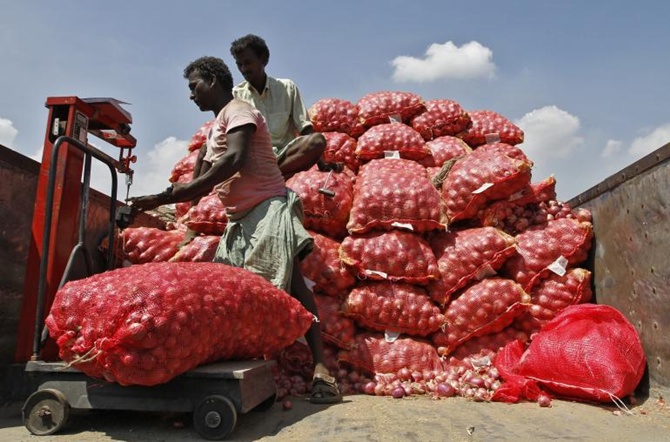Photographs: Reuters BS Bureau
The most plausible suspect for the price surge, therefore, is the inability of the market to channel onions from growers to consumers without too many intermediaries adding to costs.
Onion prices in towns have begun, finally, to come down. That follows a fresh harvest of onions in Karnataka and Maharashtra.
But the price rise could happen again - unless its causes are realistically ascertained, and the right lessons drawn.
The crisis was generally believed to have been triggered by low production, high exports and rampant hoarding.
However, the available evidence suggests that these factors could not have caused price spikes of this magnitude.
...
The real culprit behind the hike in onion prices
Photographs: Reuters
The real culprit? Inefficient and multi-tiered marketing.
Low production cannot be the reason; although onion output shrank this year by around five per cent, the projected level of 16.5 million tonnes still fell well within the normal annual production range of 16 to 17 million tonnes.
In any case, a mere five per cent shortfall could not have caused a 300 to 400 per cent rise in prices. Clearly, marketing imperfections exacerbated its impact. The export argument, too, lacks credence.
Total shipments between April and August were less than 700,000 tonnes, against more than 850,000 tonnes during the same period last year.
...
The real culprit behind the hike in onion prices
Photographs: Reuters
Moreover, the despatches in August, when the prices tended to touch the peak, were less than 30,000 tonnes, against more than 150,000 tonnes in July.
High domestic prices eroded export viability even before the government increased the minimum export price to a forbidding $900 a tonne.
Then there’s the hoarding argument. The mere presence of stocks doesn’t mean hoarding. Like many other farm goods, onions are seasonal products; they need to be preserved for off-season availability.
August and much of September are also a lean period when, in the absence of fresh arrivals from anywhere, the market relies chiefly on stored onions.
...
The real culprit behind the hike in onion prices
Photographs: Babu/Reuters
Government agencies have been working on methods so that both farmers and traders could store onions to ensure that stocks are available for the lean season.
And why would any sensible hoarder hold on to inventories when prices shoot up to record highs, and the next harvest is round the corner?
The most plausible suspect for the price surge, therefore, is the inability of the market to channel onions from growers to consumers without too many intermediaries adding to costs.
The promotion of organised retail trade with backward linkages with farmers or wholesalers at the production centres is one way to reduce the number of tiers in the marketing chain.
...
The real culprit behind the hike in onion prices
Photographs: Mukesh Gupta/Reuters
This can help narrow the gap between wholesale and retail prices - which is currently very wide since retail prices were almost 45 per cent more than wholesale prices. Organised retail trade can also raise the producers’ minuscule share in the prices paid by the consumers.
Better price realisation by farmers would encourage them to grow more to meet the rising demand. The utility of organised retail has been borne out even during the current onion crisis.
The prices at these outlets have invariably remained below those charged by local shopkeepers or street vendors. This is the lesson that should not be missed.







article